IDEX Online Research: Jewelry Stocks Under-Perform in Q1
April 10, 06
Investors who owned a portfolio of jewelry stocks had a small gain in the first quarter, but that gain was less than the overall U.S. stock market increase as measured by the S&P 500.
For the first quarter of 2006, the IDEX Online Portfolio of 13 global jewelry stocks, including internet retailers, traditional store-based jewelers, and jewelry suppliers, posted a 2.3 percent gain. In contrast, the S&P 500, a broad-based portfolio of 500 U.S. stocks, gained 3.7 percent in the three months ended March 31, 2006. On an annualized basis, jewelry stocks advanced by a notable 9.8 percent; however, the S&P posted a dramatic 14.8 percent annualized gain.
The graph below summarizes performance of the S&P 500, the IDEX Online Portfolio of jewelry stocks, and sub-groups within the IDEX Online Portfolio.
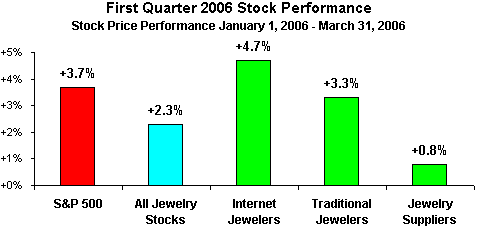 Source: Stock markets |
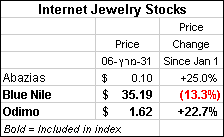 |
Internet Jewelers – Jewelry internet stocks posted the strongest gain of any of the jewelry sub-sectors: +4.7 percent in the first quarter. The share price of Blue Nile, a darling of Wall Street, fell by about 13 percent in the quarter due to investor worry about slowing growth. Blue Nile’s fourth quarter sales grew by only 13.5 percent, a slower growth rate than in prior periods. Odimo’s shares gain almost 23 percent in the quarter, though this was on a very low price-per-share base. Odimo did not file its year-end results until the end of March. Financials were disappointing, the company received a “going concern” opinion from its auditors (this means that there is reasonable doubt about the company’s ability to remain in business), and management says the company will likely lose money in 2006. In addition, management has been uncommunicative; Wall Street dislikes companies that appear to be hiding something. Thus, it is likely that Odimo’s share price will fall. Abazias’ shares trade at only $0.10 (ten cents) per share; this share price is too low to be included in the IDEX Online Portfolio.
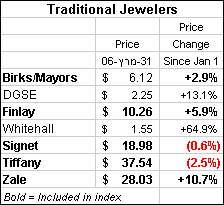 |
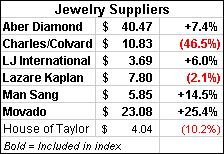 |
Jewelry Stock Prices Volatile in First Quarter
While the S&P 500 showed a gradual gain during the first three months of 2006, jewelry stock prices were much more volatile. In particular, internet jewelry stock prices lagged, and then picked up. This is due to a small sample size and a low share price of one of the two stocks in the IDEX Online Portfolio. Likewise, jewelry suppliers had their ups-and-downs during the quarter. Traditional jewelry stocks slipped significantly early in the quarter, but staged a rally near the end. The graph below shows the performance of jewelry stocks versus the S&P 500 during the first quarter of 2006.
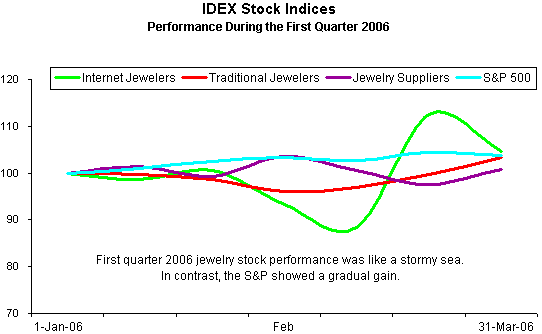 Source: Stock markets |
Outlook for Jewelry Stocks – On a short term basis, jewelry stocks react like the rest of the market – if stock traders believe that there is a recession coming, most stocks will likely fall. The good news is that most economists believe that the U.S. economy will continue to post moderate growth in 2006. Further, the market is relatively cheap. Thus, jewelry stocks should show moderate gains this year.
Long term fundamentals remain solidly in place in the jewelry industry. Consumer demographics in key markets – the U.S., Europe, Japan, and India – remain positive. The global economy appears to be growing at a moderate pace.
The biggest challenge facing jewelers is creating demand for their product. Sales gains of other categories of luxury goods continue to outpace sales gains of jewelry. In short, while the world consumer continues to embrace luxury goods, jewelers are losing market share. There are only two jewelry categories that are spending notable amounts to boost demand: luxury watches and diamonds (De Beers). Until jewelers can tell their story to consumers – advertising will help, but isn’t the cure-all – they will be left in the dust. As the proverb says, “You either make dust or you eat dust.” It is time for jewelers to stop eating dust.